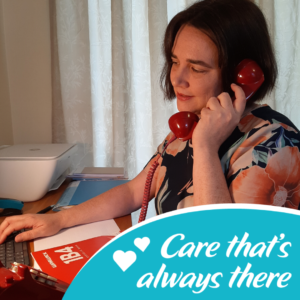In the current COVID-19 climate, Mary Potter Hospice staff are finding innovative ways to provide care. That involves medical staff using technology to continue to connect with their patients from afar.

The initiative called Telehealth was established when level four restrictions were announced. It allows doctors to contact their patients via phone or video calling to conduct consultations.
Dr Rebekah Shaw says that if a patient has a need, medical staff determine whether a Telehealth visit is appropriate as opposed to a face-to-face visit in their home.
“Each weekday morning we have a regular meeting to check in with our palliative care nurses who tell us which patients they are most concerned about. This might include patients whose symptoms need addressing or whose condition is changing. We then work out who would best benefit from a Telehealth call or from someone physically visiting.”
The aim is to minimise face-to-face contact but still provide high-quality care to patients and their whānau. Telehealth has so far proven to be a success.
“It has been positive. People have been very understanding of the situation we are in. Patients are often nervous of people from outside their bubble coming into their homes, and prefer to use Telehealth,” Rebekah says.
Video conferencing had particular benefits – being able to see the patient provided more information which doctors are able to use.
“On Zoom I can often see how they are breathing, if they are looking uncomfortable, how sick they may be and if they are in distress. All those things give me a gauge of how someone is doing. If a nurse is visiting at the same time, they can add to the physical assessment. It’s also an opportunity to put faces to names and that helps build relationships.”
“Although we can’t do some things there is still a lot we can do.”
Now the Telehealth service has been established it will likely help shape how care is provided going forward, Rebekah says.
“Telehealth does allow us to reach more people and provide care in a slightly different way. I am sure we will continue to use it for the right patients as a tool going in the future. “
While adjusting to the lockdown restrictions had gone well, Rebekah says she misses the wider Mary Potter Hospice team and the privilege of being able to be in the same room as her patients.
“Although we are still visiting patients, we are using Telehealth and telephone support more. For many of us we miss being with patients and their whānau, providing the care which comes from being physically present.”
“In saying that, patients and their families have been so understanding during this time – they have been very eager to engage in a new way – and we really appreciate that.”
